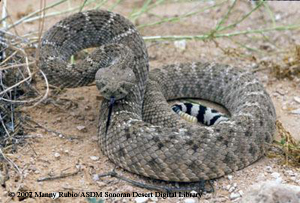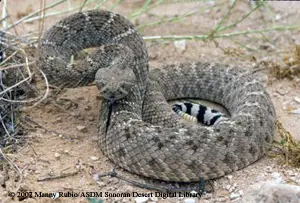The Western Diamondback Rattlesnake is one of the most iconic and feared reptiles in North America. However, with the increasing destruction of its habitat, many are wondering if this venomous creature is now endangered. In this article, we will explore the current status of the Western Diamondback Rattlesnake and what we can do to protect this vital species.
The Western Diamondback Rattlesnake is not currently listed as an endangered species. However, the population is declining due to habitat loss, overhunting, and the pet trade. Conservation efforts are in place to protect this species, and it is illegal to capture or kill them without a permit.

Is the Western Diamondback Rattlesnake Endangered?
The Western Diamondback Rattlesnake (Crotalus atrox) is a venomous pit viper species found in the western United States and parts of Mexico. The snake gets its name from the diamond-shaped markings on its back and its signature rattle, which it uses to warn potential predators. With its striking appearance and potentially deadly bite, the Western Diamondback Rattlesnake is a fascinating creature that has garnered much attention from both wildlife enthusiasts and conservationists. However, there is a growing concern that the species may be in danger of extinction.
Population and Habitat
The Western Diamondback Rattlesnake is a widespread species that can be found in a variety of habitats, including deserts, grasslands, and forests. They are most commonly found in the southwestern United States, particularly in Arizona, New Mexico, and Texas. In Mexico, they are found in the states of Sonora, Chihuahua, and Sinaloa. Despite their wide range, the Western Diamondback Rattlesnake is facing a number of threats to its population and habitat.
One of the biggest threats to the Western Diamondback Rattlesnake is habitat loss. As human populations continue to grow and expand into wild areas, the snake’s natural habitat is being destroyed or fragmented. This can lead to a loss of food sources, mating opportunities, and shelter, which can have a significant impact on the snake’s overall population.
Another major threat to the Western Diamondback Rattlesnake is the illegal pet trade. Many people are drawn to the snake’s striking appearance and keep them as pets. However, this practice is illegal and can have a devastating impact on wild populations. Captive-bred snakes that are released into the wild can introduce diseases or genetic traits that are not naturally found in the wild population, which can have negative consequences for the species as a whole.
Conservation Efforts
Efforts are being made to protect the Western Diamondback Rattlesnake and its habitat. The species is listed as a protected species in both the United States and Mexico, which means that it is illegal to harm, kill, or capture the snake without a permit. Additionally, many organizations are working to educate the public about the importance of conserving the species and its habitat.
One of the most effective ways to protect the Western Diamondback Rattlesnake is to preserve its natural habitat. This can be done through a variety of methods, including habitat restoration, land management practices, and the establishment of protected areas. By preserving the snake’s habitat, we can ensure that the species has access to the resources it needs to survive and thrive.
Another important conservation effort is the monitoring of wild populations. Researchers are studying the snake’s behavior, reproduction, and movement patterns to gain a better understanding of the species and its needs. This information can be used to develop effective conservation strategies that will help to protect the Western Diamondback Rattlesnake and its habitat for future generations.
The Future of the Western Diamondback Rattlesnake
While there is no doubt that the Western Diamondback Rattlesnake is facing significant threats to its population and habitat, there is still hope for the species. With continued conservation efforts and public awareness, we can work to protect this fascinating creature and ensure that it continues to thrive in the wild.
One of the most important things we can do to protect the Western Diamondback Rattlesnake is to educate the public about the importance of conservation. By raising awareness about the threats facing the species and its habitat, we can encourage people to take action to protect it.
Another key factor in the future of the Western Diamondback Rattlesnake is the continued research and monitoring of wild populations. By studying the snake’s behavior and needs, we can develop effective conservation strategies that will help to protect the species and its habitat for years to come.
In conclusion, the Western Diamondback Rattlesnake is a fascinating and important species that is facing significant threats to its population and habitat. However, with continued conservation efforts and public awareness, we can work to protect this iconic snake and ensure that it continues to thrive in the wild.
Frequently Asked Questions
Here are some frequently asked questions about the Western Diamondback Rattlesnake and its endangered status.
What is the Western Diamondback Rattlesnake?
The Western Diamondback Rattlesnake is a venomous snake species found in the southwestern United States and Mexico. It is known for its distinctive diamond-shaped pattern on its back and its rattle, which it uses to warn predators.
The Western Diamondback Rattlesnake is an important predator in its ecosystem, keeping rodent populations in check and serving as a food source for other animals.
Why are Western Diamondback Rattlesnakes important?
Western Diamondback Rattlesnakes play an important role in their ecosystem. They help control rodent populations, which can cause damage to crops and spread disease. They are also a food source for other animals.
In addition, Western Diamondback Rattlesnakes have been used in medical research to develop new treatments for diseases such as cancer and heart disease.
What is the current status of the Western Diamondback Rattlesnake?
The Western Diamondback Rattlesnake is not currently listed as endangered by the United States Fish and Wildlife Service. However, some states have listed it as a species of concern due to habitat loss and other threats.
It is important to continue monitoring the population of Western Diamondback Rattlesnakes and taking steps to protect their habitat to ensure their long-term survival.
What are the threats to the Western Diamondback Rattlesnake?
The main threats to the Western Diamondback Rattlesnake are habitat loss and fragmentation due to development and agriculture, as well as being killed by humans due to fear or misunderstanding.
Climate change may also have an impact on the Western Diamondback Rattlesnake’s habitat and prey availability in the future.
What can be done to protect the Western Diamondback Rattlesnake?
To protect the Western Diamondback Rattlesnake, it is important to preserve and restore its habitat. This can be done through land conservation and management practices that protect critical habitat areas. It is also important to educate the public about the importance of the Western Diamondback Rattlesnake and how to safely coexist with it.
In addition, laws and regulations can be put in place to protect the Western Diamondback Rattlesnake from being killed or captured without a permit.
This Snake Needs SERIOUS Help! – Why Eastern Diamondback Rattlesnakes Are “Endangered”!
In conclusion, despite the Western Diamondback Rattlesnake being a highly venomous species, it is a valuable part of the ecosystem. However, due to factors such as habitat loss, climate change, and human persecution, this species is facing a high risk of endangerment. It is crucial that conservation efforts are made to protect the Western Diamondback Rattlesnake and its habitat, as the loss of this species would have significant ecological and economic impacts. By working together to protect this species, we can ensure that future generations can appreciate the beauty and importance of the Western Diamondback Rattlesnake in their natural environment.


